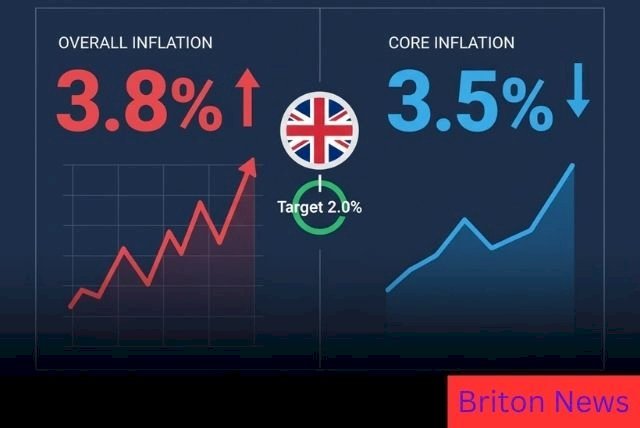UK Inflation Stays Above Target at 3.8%; Core CPI Slips Slightly to 3.5%
The latest ONS report shows the UK inflation rate steady at 3.8% in September 2025, with core CPI at 3.5%. Learn why UK inflation is still high in 2025, when it might go down, and how the Bank of England controls inflation amid the British living cost crisis.

The latest ONS inflation report for September 2025 confirms that the UK inflation rate remains stubbornly high at 3.8%, unchanged from August. The Consumer Prices Index (CPI) continues to sit well above the Bank of England’s 2% target, underscoring ongoing pressure on households and businesses across Britain.
According to the Office for National Statistics (ONS), core CPI — which excludes volatile items such as food, energy, alcohol, and tobacco — eased slightly to 3.5%, down from 3.6% in August. Meanwhile, the CPIH, a broader measure including owner occupiers’ housing costs, stood at 4.1%.
These figures show that while the pace of inflation is no longer accelerating, prices remain elevated, contributing to what analysts are calling the British living cost crisis 2025.
UK Inflation September 2025: ONS Confirms Persistent Price Pressure
The ONS inflation report September 2025 highlights that transport and housing costs were the main contributors to price growth in England, while food and recreation prices saw modest declines. The report reflects a nation still grappling with the impact of inflation on UK families, particularly in cities such as London, where the cost of living in 2025 remains significantly above the national average.
Economists say the current inflation rate UK has been “stuck” in the high-3% range since July, showing resilience despite tighter monetary policy. Compared with other advanced economies, the inflation rate in Britain today remains higher than in the United States and eurozone countries, where price growth has slowed more sharply.
Why Is UK Inflation Still High in 2025?
A key question dominating the latest UK inflation news is: why is UK inflation still high in 2025?
Experts point to several interlinked causes. Energy prices have remained volatile due to continued tensions in global markets, while transport costs and rents have risen sharply. Labour shortages in certain sectors have also led to sustained wage pressures, feeding into service prices.
Even though food prices have stabilised, the inflation England data shows that energy bills and housing costs continue to exert significant upward pressure. This persistence keeps the UK inflation rate above the BoE’s target, making it difficult for policymakers to ease monetary conditions.
Bank of England Inflation Update and Interest Rate Outlook

Image source: pinterest.com
The Bank of England inflation update shows the base interest rate remains at 5.25%, a level maintained since mid-2024. The Bank’s Monetary Policy Committee (MPC) is expected to hold rates again at its next meeting on 6 November 2025, unless inflation shows signs of renewed acceleration.
Governor Andrew Bailey recently stated that the central bank needs “clear evidence of sustained disinflation” before considering any rate cuts. The Bank continues to rely on tight monetary policy as its main tool for how the Bank of England controls inflation, with the goal of steering CPI closer to the 2% target by mid-2026.
The high base rate has also raised mortgage and loan costs, deepening the impact of inflation on UK families. Renters, in particular, have been hit by a combination of rising interest rates and higher landlord costs, intensifying the London cost of living 2025 problem.
UK Inflation and Interest Rates: Balancing Growth and Stability
The challenge for policymakers lies in balancing the fight against inflation with the need to support economic growth. Analysts at Briton News note that while inflation is gradually cooling, high borrowing costs are slowing investment and household spending.
The UK economic outlook October 2025 remains mixed: business confidence is improving slightly, but consumer confidence remains fragile. Many small firms continue to struggle with high input costs and weaker demand, particularly in retail and hospitality sectors.
Financial markets expect the Bank of England to maintain the 5.25% base rate through the rest of 2025 before potentially beginning gradual cuts in 2026 — if inflation continues to fall.
UK Inflation vs US Inflation 2025: Global Perspective
The UK inflation vs US inflation 2025 comparison reveals that Britain’s price growth remains higher. In the US, headline inflation recently fell to 3.2%, while the UK inflation rate has held firm at 3.8%. Analysts attribute this gap to stronger domestic cost pressures in Britain, particularly in the services sector, and slower energy price adjustments.
This divergence highlights the broader structural differences between the two economies, with the UK’s labour market tightness and import dependency continuing to affect prices.
When Will UK Inflation Go Down?
According to projections from the Bank of England and leading financial institutions, inflation is expected to gradually decline in early 2026 as energy costs stabilise and base effects fade. However, economists warn that the path down may be uneven.
Many households remain cautious, with the current inflation rate UK still eroding disposable income. “Even if CPI dips below 3% by mid-2026, the scars of the cost-of-living squeeze will linger,” said an analyst quoted by Briton News.
The inflation forecast UK October 2025 suggests modest relief over the next six months, but a return to the BoE’s 2% target could take longer if wage growth remains strong.
UK Inflation Report Explained: What It Means for Everyday Britons
In simple terms, the uk inflation report explained by ONS shows that prices are no longer rising faster each month, but they’re still rising overall — just at a slower pace. That means everyday goods and services remain more expensive than they were a year ago.
The england inflation data 2025 continues to show disparities between regions, with London and the South East facing higher living costs compared to the Midlands and Northern England.
As the Bank of England holds rates steady, consumers and businesses alike are waiting for signs of a true cooldown. For now, UK inflation September 2025 remains elevated, leaving policymakers cautious and families under continued financial strain.
Summary
The current inflation rate UK of 3.8% may signal stability after months of turbulence, but it remains a reminder that Britain is not yet past its inflation challenge. As the Bank of England prepares for its November 2025 review, the focus will be on whether sustained moderation in core CPI and easing global pressures can finally bring relief to households and businesses.
Until then, the UK inflation rate continues to dominate the latest UK inflation news, shaping economic decisions across the nation.
Frequently Asked Questions on UK Inflation 2025
1. Why is UK inflation still high in 2025?
The UK inflation rate remains high in 2025 mainly due to elevated housing, transport, and energy costs. Although food prices have eased, rising rents and service sector wages continue to drive inflation. According to the ONS inflation report September 2025, the current inflation rate UK stands at 3.8%, well above the Bank of England’s 2% target. Analysts at Briton News note that this persistence shows how structural pressures are keeping inflation in England higher than expected.
2. When will UK inflation go down?
Economists expect UK inflation to gradually decline in early 2026, provided global energy prices stabilise and wage growth slows. The inflation forecast UK October 2025 indicates a possible drop to around 3% by mid-2026, though the timeline depends on Bank of England policy decisions. Until then, the current inflation rate UK will likely remain above target, extending the British living cost crisis 2025 into next year.
3. How Bank of England controls inflation?
The Bank of England controls inflation mainly through interest rate adjustments. When the inflation rate in Britain today is too high, the Bank raises its base rate — currently 5.25% — to make borrowing costlier and slow spending. This helps stabilise prices but can also strain households and businesses. The Bank of England inflation update in October 2025 confirms that policymakers will keep rates steady until clear signs of disinflation appear.
4. What keeps prices high in the UK?
Several factors keep prices high in the UK, including increased energy costs, labour shortages, and rising housing expenses. Despite stable global oil prices, domestic service costs and supply chain disruptions still affect the UK CPI September 2025 figure. These persistent pressures explain why UK inflation is still high in 2025, even as other economies see faster improvement.
5. UK inflation vs US inflation 2025 — how do they compare?
In 2025, the UK inflation rate is higher than that of the United States. The UK CPI sits at 3.8%, while US inflation is around 3.2%. The gap reflects stronger wage and housing pressures in Britain. Analysts at Briton News suggest that UK inflation vs US inflation 2025 comparisons show Britain’s economy facing slower disinflation due to its dependence on imports and a tight labour market.
6. What is the British living cost crisis 2025?
The British living cost crisis 2025 describes the prolonged strain on household budgets caused by high inflation, elevated rents, and expensive utilities. Even with inflation stabilising, the impact of inflation on UK families remains severe. Many households spend a larger share of income on essentials, particularly in London, where the cost of living 2025 remains the highest in England.
7. What is the impact of inflation on UK families?
The impact of inflation on UK families includes reduced purchasing power, higher mortgage payments, and rising grocery bills. Families on fixed incomes are struggling the most as wages lag behind inflation. According to Briton News, the uk inflation and interest rates dynamic has also made borrowing more expensive, pushing more households to cut back on non-essential spending.
8. What is the inflation forecast for UK October 2025?
The inflation forecast UK October 2025 points to continued stability at around 3.8%, according to the ONS inflation report September 2025. Economists predict modest declines toward 3.5% by the end of the year. The Bank of England is expected to maintain its 5.25% base rate during the November policy review, focusing on long-term price stability before considering rate cuts in 2026.
















